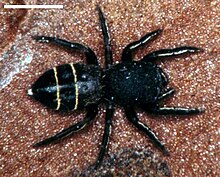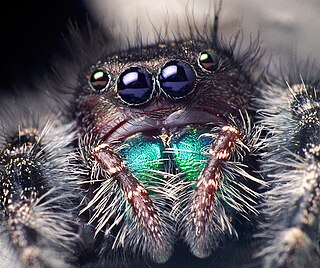
Phidippus is a genus in the family Salticidae. Some of the largest jumping spiders inhabit this genus, and many species are characterized by their brilliant, iridescent green chelicerae. Phidippus is distributed almost exclusively in North America, with the exception of two exported species. As of January 2021, there were about 80 described species in the genus. Species previously described in Phidippus which are found in India and Bangladesh do not belong in this genus.

Habronattus is a genus in the family Salticidae. Most species are native to North America. They are commonly referred to as paradise spiders due to their colorful courtship ornaments and complex dances, similar to birds-of-paradise.

Bagheera is a genus of jumping spiders within the family Salticidae, subfamily Salticinae and subtribe Dendryphantina. The genus was first described by George Peckham & Elizabeth Peckham in 1896. The name is derived from Bagheera, a character from Rudyard Kipling's Jungle Book.
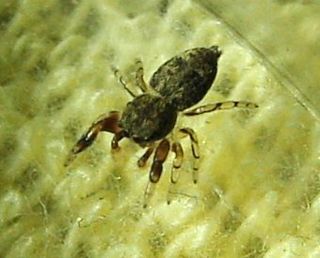
Ballus is a spider genus of the family Salticidae.
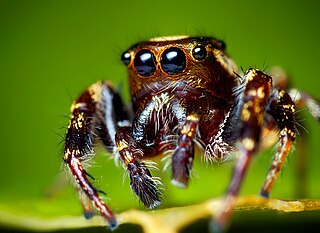
Eris is a genus of the spider family Salticidae. It is native to North and South America. As is typical for salticids, they are not defensive. While larger specimens could potentially bite, an envenomation would pose no danger to a human.

Hakka himeshimensis is a species of the spider family Salticidae. It is the only species in the genus Hakka. H. himeshimensis is native to East Asia, but has been introduced to the United States. It is most commonly found in rocky coastal habitats.

Lyssomanes is a spider genus of the family Salticidae, ranging from South and Central America, up to the southern United States.
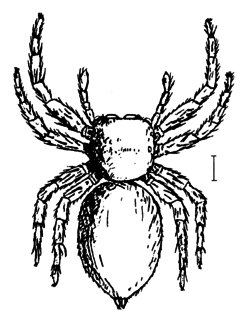
Mantius is a spider genus of the jumping spider family, Salticidae.

Margaromma is a spider genus of the jumping spider family, Salticidae. The eight described species occur mostly in Australia and New Zealand, with several other species on Pacific islands. One species is found in Cameroon.

Metacyrba is a genus of jumping spiders that was first described by Frederick Octavius Pickard-Cambridge in 1901. The name is combined from Ancient Greek μετά "after, beside" and the salticid genus Cyrba.
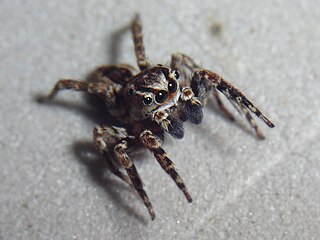
Mexigonus is a genus of North American jumping spiders that was first described by Glavis Bernard Edwards in 2003. The name is a reference Mexico, where the first identified species were found.

Naphrys is a genus of North American jumping spiders that was first described by Glavis Bernard Edwards in 2003. The name is a portmanteau of "North America" and "Euophrys".

Pelegrina is a spider genus of the family Salticidae. They are found throughout North America. Many of the species in Pelegrina were previously placed in the genera Metaphidippus, and before that, Dendryphantes. The genus was originally described in 1930 by the Spanish arachnologist Pelegrín Franganillo Balboa, who named it after himself.

Pellenes is a genus of jumping spiders that was first described by Eugène Louis Simon in 1876. It is considered a senior synonym of Hyllothyene.

Zygoballus is a genus of jumping spiders found in North and South America.

Bagheera kiplingi is a species of jumping spider found in Central America, including Mexico, Costa Rica, and Guatemala. It is the type species of the genus Bagheera, which includes three other species, including B. prosper. B. kiplingi is notable for its peculiar diet, which is mostly herbivorous. No other known species of omnivorous spider has such a markedly herbivorous diet.

Zygoballus sexpunctatus is a species of jumping spider which occurs in the southeastern United States where it can be found in a variety of grassy habitats. Adult spiders measure between 3 and 4.5 mm in length. The cephalothorax and abdomen are bronze to black in color, with reddish brown or yellowish legs. The male has distinctive enlarged chelicerae and front femora. Like many jumping spiders, Z. sexpunctatus males exhibit ritualized courtship and agonistic behavior.

Zygoballus rufipes, commonly called the hammerjawed jumper, is a species of jumping spider which occurs in the United States, Canada, and Central America. Adult females are 4.3 to 6 mm in body length, while males are 3 to 4 mm.

Attidops youngi is a species of jumping spider in the family Salticidae. It is found in the United States and Canada.
